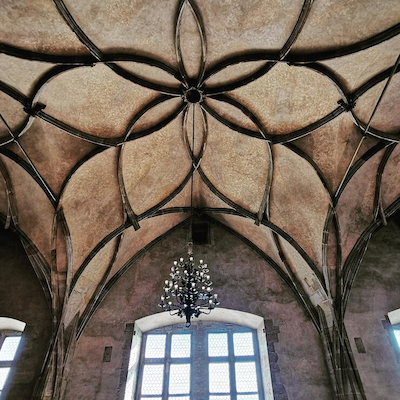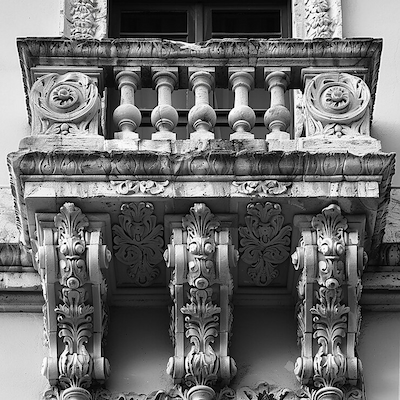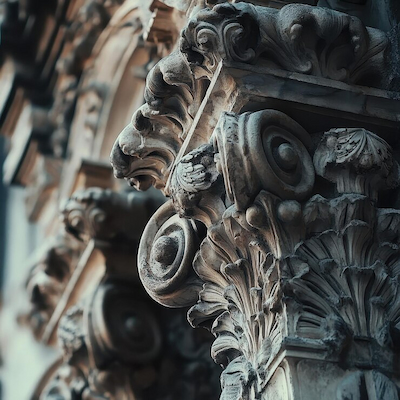
Baroque architecture is one of the most fascinating and complex styles in the history of art and architecture. Emerging in the late 16th century and continuing into the 18th century, this style is characterized by its exuberance, intricate ornamentation, and an incessant pursuit of movement and emotion. Baroque developed in a cultural and historical context full of change, influenced by factors such as the Protestant Reformation, the Catholic Counter-Reformation, and the rise of absolutism. Baroque buildings are not just physical structures; they are visual narratives that reflect the aspirations and conflicts of their time.
In this article, we will explore the key elements that define Baroque architecture, from its ornamental features to the dramatic intensity that pervades its forms. Through a detailed analysis, we aim to understand how these elements interact to create unique visual experiences that continue to impact art and culture today. Baroque architecture is not only a testimony of the past but a source of inspiration that resonates to this day.
How Baroque Architecture Elements Work
The elements of Baroque architecture work together in harmony to create an unmistakable visual and emotional effect. Ornamentation is one of the pillars of this style, where every detail is meticulously planned to convey a message. The facades of Baroque churches and palaces are often adorned with sculptures, reliefs, and decorative elements that capture attention and encourage contemplation. These adornments are not merely aesthetic; they have a narrative purpose, telling biblical stories or glorifying important figures of the time.
Movement is another central characteristic of Baroque architecture. Unlike the rigidity and symmetry of the earlier Renaissance style, Baroque seeks to create a sense of dynamism. This is achieved through curvilinear forms, asymmetric structures, and the use of light and shadow to create depth. Baroque churches, for example, often feature floor plans in the shape of a cross, but with arms that expand and contract, creating a sense of movement and fluidity. This use of space not only attracts the eye but also evokes emotions, taking the viewer on a visual journey.
Additionally, Baroque sculpture deserves attention for its expressiveness. Artists like Gian Lorenzo Bernini transformed sculpture into a means of telling dramatic and engaging stories. The sculpted figures seem to come to life, expressing intense emotions and capturing moments of action. This realism and emotional intensity set Baroque sculpture apart from earlier periods, where rigidity and idealization were more common. Thus, Baroque sculpture is not just a complement to Baroque architecture but an integral part that contributes to the overall narrative of the work.
Finally, the interaction between the different elements of Baroque architecture creates immersive experiences. When entering a Baroque space, the viewer is enveloped by an atmosphere that combines light, shadow, form, and ornamentation. This sensory experience is intentional, designed to provoke an emotional and spiritual response. Baroque architecture is not just about what is seen but about what is felt, making it an art form that transcends time and continues to resonate with human emotions.

Benefits of Understanding Baroque Architecture: Ornamentation, Movement, and Drama in Stone
Understanding Baroque architecture offers several advantages that go beyond aesthetic appreciation. First, Baroque ornamentation is a window into the culture and society of the time. Every carved or painted detail carries profound meanings that reflect the beliefs, values, and ambitions of Baroque society. By studying these elements, we can gain insights into the history of art, religion, and politics of the period, enriching our understanding of the past.
Moreover, the movement present in Baroque architecture is a representation of human emotions. The fluidity of forms and the dramatic nature of architectural compositions evoke feelings that resonate to this day. By recognizing this emotional intent, scholars and art enthusiasts can develop a deeper appreciation for architecture’s ability to communicate and provoke reactions. This is especially relevant in a world where contemporary architecture often seeks an emotional connection with the audience.
Another important point is the lasting influence of Baroque architecture on subsequent styles. Baroque did not disappear with the rise of Neoclassicism; on the contrary, its features were reinterpreted and adapted into various artistic movements throughout history. Therefore, understanding Baroque architecture is essential for any study of the evolution of art and architecture, as many of the techniques and concepts developed during this period are still applied today.
Finally, Baroque architecture is a constant source of inspiration for contemporary artists, architects, and designers. Its visual richness and expressiveness challenge creators to explore new forms of expression and consider the interaction between space and emotion. By studying Baroque architecture, art and design professionals can find new ways to connect with their audiences and create works that resonate deeply.
How Baroque Architecture Influences Art and Culture
-
Baroque ornamentation brings visual richness and detail, elevating the aesthetic experience to a new level. Baroque churches and palaces are true art galleries, where every detail is designed to surprise and delight.
-
Baroque movement reflects intense, dramatic emotions, creating a visceral connection between the viewer and the work. This quest for expressiveness continues to inspire contemporary artists to explore the relationship between form and feeling.
-
Baroque sculpture stands out for its expressiveness and realism, capturing moments of action and emotion with impressive skill. The works of Baroque sculptors like Bernini are still studied and admired for their ability to bring marble to life.
-
Baroque influence is still felt in contemporary styles, where elements like asymmetry and ornamentation are reinterpreted. Modern architects often incorporate Baroque aspects to create spaces that challenge norms and provoke an emotional response.
-
Baroque architectural details create immersive experiences, transforming the perception of space. Every angle, every play of light and shadow is designed to guide the viewer’s gaze and emotions, making a visit to a Baroque space a memorable experience.
-
Baroque artistic expression marks a turning point in art history, representing an era of innovation and boldness. Studying Baroque architecture allows us to understand the cultural and artistic transitions that shaped the modern world.
Baroque architecture, therefore, is not just a style of the past but a rich source of inspiration and reflection that continues to influence contemporary art and culture. By exploring its features and impacts, we can better appreciate the complexity and beauty of this fascinating period in history.

Did You Enjoy Learning About Baroque Architecture: Ornamentation, Movement, and Drama in Stone?
Baroque architecture is a subject that fascinates and intrigues, offering a rich tapestry of visual and emotional experiences. By delving into its characteristics, such as ornamentation, movement, and drama, we are invited to reflect on the interaction between art, history, and culture. Each element tells a story that resonates through the centuries.
We hope this article has sparked your interest in Baroque architecture and its nuances. As you explore more about this topic, you will discover a world of beauty and meaning that continues to inspire and move. Baroque architecture is a celebration of human creativity and proof that art can transcend time.
Frequently Asked Questions
What is Baroque architecture?
Baroque architecture is a style that emerged in the 17th century. It is marked by intricate details and emotion.
What are the main characteristics of Baroque ornamentation?
Baroque ornamentation is rich and exaggerated. You will see many details like curves, flowers, and angels. The goal is to impress and evoke emotion.
How did the Baroque movement stand out in art?
The Baroque movement stood out for its dramatic nature. The works convey intense and captivating emotions.
What materials are most used in Baroque architecture?
In Baroque architecture, stone, marble, and wood are commonly used. These materials help create the grandeur of the style.
Where can I see examples of Baroque architecture?
You can find Baroque architecture in churches and palaces. Visit historic cities to experience ornamentation, movement, and drama in stone firsthand!
How did Baroque architecture influence modern architecture?
Baroque architecture influenced modern architecture by inspiring the use of dramatic forms, asymmetry, and ornamentation. Many contemporary architects incorporate Baroque elements to create spaces that evoke emotion and challenge conventional design.

